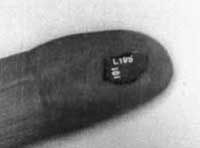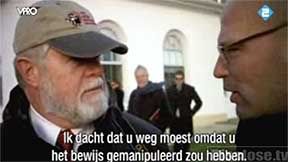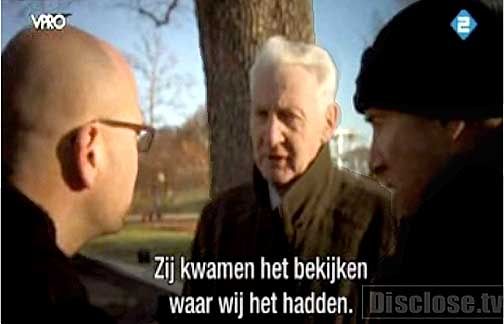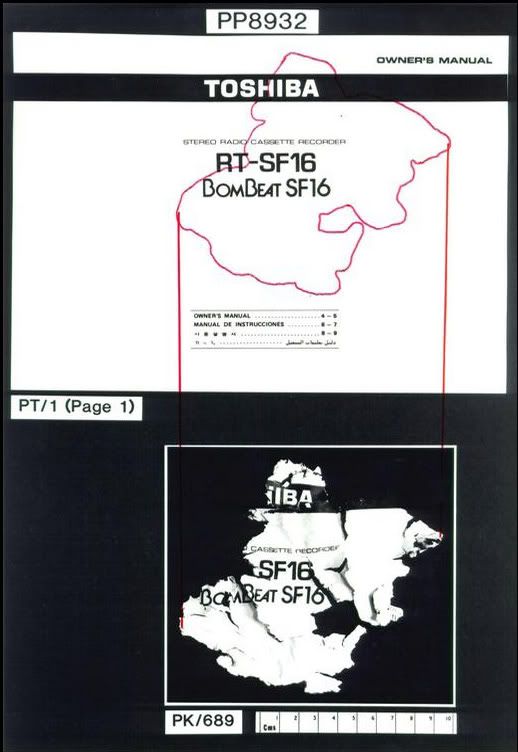First Posted 26 October 2010
last edits 29 October
Introducing Allen Feraday
At the time of the Pan Am 103 bombing, Allen William Feraday was the top deputy to Dr. Thomas Hayes, head of the forensic explosives laboratory for RARDE, the Royal Armament Research and Development Establishment. Following Hayes’ departure in latter 1989 - to become a foot doctor - Feraday took his position as the lab‘s director. Both men were formative in the science of the Lockerbie bomb suitcase, as officially understood. Their work on that ran parallel to the shuffling about, which was apparently connected to a probe of Hayes’ involvement in the shady Maguire Seven case of 1976 (see link above).
Patrick Haseldine’s famously deleted Wikipedia page on Alan Feraday sums up nicely that he “has appeared as an expert witness at criminal trials leading to convictions in at least four high-profile cases, three of which were subsequently overturned on appeal. The appeal in the fourth case is ongoing.” [1] Of course that last is no longer pending, as of August 2009 when Abdelbaset al-Megrahi surrendered his appeal of conviction for the bombing of flight 103. I’m not entirely sure how many other cases he’s been involved in and how these turned out, but the four are interesting and I’ll opt to show the same basic bias, aside from mention of a fifth case that has been challenged but not to my knowledge overturned.
On the other side of the spectrum of opinion, David Leppard, in On the Trail of Terror, offers effusive praise for the man erroneously named in the index as “Dr. Allen Feraday.” [2] It’s been widely acknowledged he has no formal training on a doctorate level, only a Higher National Certificate in Applied Physics and Electronics that was apparently pretty old; according to Leppard, the good “doctor” had beneath his belt a solid “34 years explosives experience” as of writing in 1991 (or since 1957, by my math). [2 p74] A 2005 article by Michael Tierney and run in the Herald (Scotland) said Feraday was then “in his sixties,” and had retired a decade earlier with “42 years” experience. [3] If that’s all true, he could be born no later than 1935, and started work with bombs in 1953, at around age 18 at the oldest.
Just what he was doing there for the decades before the 1980s is unclear from available evidence. But he acts like a paranoid spook, as Leppard’s book expands:
"Not surprisingly both Feraday and Hayes were high on the IRA’s death list. ‘He’s very, very good, so obviously he’s subject to high-level security precautions,’ said a Scotland Yard Bomb Squad expert who has worked closely with Feraday on IRA cases.
Feraday is the archetype of the secret scientist. He travels to work in a hire car which he changes every week. Even some of his closest colleagues do not know where he lives; just that he has a wife and family and they live somewhere in the south of England.” [2 p74-75]Fighting Terrorism with Circuitry
But the phase of his career under consideration here is less about bombs than about electronics. The oldest of the high profile cases in question was only in 1983, with the prosecution of businessman John Berry, a former Royal Marine Commando. His company was selling electronic timers to the Syrian government. He didn’t seem to know what exactly they were to be used for, but it could have been anything, he and his defense argued. But the judge didn’t buy it after hearing the Crown's lone expert witness, the eminent Allen Feraday.
"I am of the opinion that they have most probably been specifically designed and constructed for terrorist purposes. I am unable to contemplate their use other than in a bombing context." [3]As Michael Tierny described it in his amazing 2005 Herald article, Feraday’s assertion was that “the absence of safety devices in the timers prevented their use for legitimate purposes.” [3] Mr. Berry was sentenced to eight years for arming Arab terrorists, later reduced to six. He served less than four before he was released, Tierny reports, but was left legally guilty in his broken life. [3]
Another man locked up for supplying terrorists was a businessman named Hassan Assali, originally from Libya, but British for twenty years. He was accused, again, of constructing electronic timers for the sole purpose of making bombs. Almost robotically, the Crown’s sole scientific witness – Feraday – affirmed their case: "I am unable to contemplate their use in other than terrorist bombs.” [3] On 24 May, 1985, Assali was convicted based on this scientific basis and sentenced to a middling term. His appeal against conviction was rejected in 1986, and he served nearly seven years before managing an early release in 1992. [3] [1] While free, he remained legally guilty like Berry.
Neither of these cases involved any actual bombs going off and killing anyone, but Feraday's next case would ratchet up his profile and the gravity of his magic. In 1986 came a break in the four-year-old Hyde Park bombing by unknown elements of the Irish Republican Army. The July 1982 blast of a 25lb. nail bomb during a military ceremony, along with a near-synchronous sister bombing at Regents Park, took nearly a dozen lives, wounded many, killed several horses, and damaged much property. This was indeed a shocking crime the IRA claimed credit for, but the exact perpetrators remained unidentified for years.
An arms cache found in the woods was eventually found to feature a nondescript circuit board which was - according to Feraday - similar to the one used in the bomb at Hyde Park. Thus linking the cache to the bombing, attention turned to the few readable fingerprints on the intact board. These were actually on the tape used on the board, and were matched to one Danny McNamee, an electronics engineer in Northern Ireland.
McNamee was arrested on 16 August 1986, and tried at the Old Bailey in 1987, presented as the bombing’s mastermind. Aside from the fingerprints, Tierney writes, “the Crown's key scientific witness, Allen Feraday, said the two [boards] were matched in design and "artwork" and therefore made by the same master bombmaker.” [3] It seems there was no other class of valid evidence against McNamee – he denied IRA involvement, and the IRA backed him up. [4] But the board, the tape, and the prints, made it clear who had done it, the Crown maintained.
Electronics expert Michael Scott. PhD spoke in the documentary film The Maltese Double Cross (1994). The McNamee case was Dr. Scott’s first view of Feraday’s work. Invited to observe from the gallery, he was able to see the same pattern the RARDE man had used in the first two cases:
“I watched Feraday and I gradually became aware that he was giving the evidence a certain emphasis that really wasn't justified, that technically couldn't be justified. […] Allen Feraday maintained, wrongly in my view, that the electronics was intrinsically sinister. [… and in handling the board, McNamee] had to be knowingly involved in bomb construction.” [5]Mr. McNamee, his planned wedding obviously cancelled, was sentenced to 25 years. His appeal of conviction was denied in 1991, and an attempted escape in 1994 didn’t help his chances of being cleared or freed. [6]
So in at least three cases prior to Lockerbie, old-time explosives expert Allen Feraday had been able to convince judges, with his advanced science and royal credentials, that any scrap of that newfangled electronics could be proven to show terrorist intent. Taken as indisputable science, his voodoo informed the legal realities created in all three cases. Men who would later be found innocent were made guilty.
Top of His Game: Gibralter and Lockerbie
In his 1991 book, David Leppard glossed over all three cases above, only claiming erroneously that Feraday had “helped Scotland Yard trap the IRA gang” responsible for the Hyde park bombing, and he did it in 1982. Instead, he wrote that “Feraday first came to public notice six years later, in 1988, during the inquest in Gibralter into the deaths of three unarmed IRA terrorists gunned down by soldiers from the Special Air Services (SAS).” [2 p74] It was a controversial action the SAS explained by each of the three reaching for their pockets or purse, presumably to detonate a car bomb they feared might exist nearby. There were no detonators, no bomb, no other weapons. Just dead IRA members, murdered, some said.
Leppard explains the role of Feraday’s testimony at the inquest was “giving a scientific rationale to the controversial decision.” [2 p74] The counter-argument, accepting the apparent plans to build a car bomb, was that the three were too far from the car in question to have triggered it, and the SAS men should have known that. But Feraday claimed from his vast knowledge of such things that the device, as Tierney puts it, “could have been triggered from anywhere in Gibraltar, or even from Spain.” [3] Dr. Michael Scott was called on in this inquest, and told the Maltese Double Cross:
"Particularly my experience in the Gibralter casse, one thing that struck me then at the time, very strongly - the British government employs hundreds of people, extraordinarily well qualified, in the areas of radio communications and electronics. Alan Feraday is not qualified, yet they use him? I mean, I have to ask the question 'why?'" [5]Leppard notes how Prime Minister Margaret Thatcher took an interest in Feraday following this favorable inquest. “Clearly grateful for his efforts, [she] arranged that he be awarded an OBE in the 1988 New Year’s honours list.” [2 p75] Tierney reports that this was in June 1989, for “the Queen's birthday honours.” [3] OBE is not a doctorate, it’s the Order of the British Empire, an elite club based on some type of chivalry, dating from World War I. Motto: For God and the Empire. [7]
At the same end of that celebrated year, Mr. Feraday OBE found himself taking a leading role in his most historic case yet. For an article already this expansive, a detailed look at Feraday’s involvement in the Lockerbie investigation would be rather excessive. In brief however, he again showed a fascination with the electronics end of things and what could be discerned from the radio parts and other circuitry recovered. Unlike his earlier cases against Berry and Assali, the apparent blast origin of these fragments show the terrorist intent in itself – unless, as I suspect, all electronics were planted to fit a master script. Feraday had to rely on the electronics evidence signed off for by Dr Thomas Hayes who, for what it’s worth, has been known to sign off for sham science in the Maguire Seven case.
At the moment, some glimpses of the insanity of Feraday’s science can be found in these existing articles:
"Lightly explosion damaged" deals at length with an apparently irrelevant sideline of nonsense - obvious explosion damage that must be something else. But Hayes’ rambling under questioning reveals much about the nature of his collaboration with Feraday that makes it often hard to pin down just where the one scientist ends and the other begins.
Timeline: Toshiba radio identification covers Feraday's convoluted assembly of clues to what radio was used. The model settled on finally was the same as his first guess, but with a black case instead of white. It would be found to suggest Libyan authorship.
The Indian Head forensic tests were held in Maryland, spring 1989, with Tom Thurman of FBI and Harry Bell of the Scottish police. These bomb tests were carried out with five devices made by Feraday, using the radio model he had identified at the time. These helped investigators rule out a Heathrow introduction.
Feraday's forensic follies, section sixty-seven looks at the confused timeline between the pivotal Libya-catching timer fragment PT/35(b) and a piece of radio circuit board called PT/30. He didn’t mention the former until four months after its alleged discovery, and the day after looking into the latter, whose identity was already known months ago.
And when PT/35(b) finally went across the pond to controversially visit agent Thurman in the United States, it was reportedly in the possession of Alan Feraday. This is a point I havem't sorted out, but some support can be found in this post.
Feraday’s 'backseat driver' Dr. Scott, cited twice above, was talking this whole time to a documentary about the Lockerbie investigation. On this core subject, he said:
“I haven’t seen the Lockerbie evidence, so I can’t comment on that directly. The involvement of Alan Feraday – Hmmm - that worries me.” [He mentions the Gibralter case here, as cited above, ending with] “yet they use him? I mean, I have to ask the question ‘why?’”
Post Lockerbie – Work Undone
Our anti-hero continued running the forensic explosives lab at RARDE through the early 1990s, all five of the high-profile cases above safe and sound as legal reality. David Leppard tried to interview Feraday for his 1991 book, but “the Ministry of Defence press office, citing national security, declined to give the author clearance to interview him.” [2 p74-75]
In 1992 his earliest victim, John Berry, was granted an appeal of his conviction. He was a free man by then, but wanted his name back. John Tierney describes his amazing appeal, with a roster of impressive experts assembled by his legal team. These names, which appear elsewhere in connection to the Lockerbie case, were listed as:
“Major Owen Lewis (retired), who served with the Royal Signals for 22 years […] Lt Colonel John Wyatt (retired; a 23-year veteran of the Royal Engineers, involved in bomb disposal and counter terrorist operations) […] Dr. Bora." [3]These experts ridiculed Feraday’s lone assertion that Berry’s timers could only be used for explosive mayhem. They were simply timers and could easily be used for turning on the cameras or sprinklers, or a hot water heater. The Court of Appeals quashed Mr. Berry's conviction in 1993, noting that Feraday’s evidence was both wrong and “extremely dogmatic […] uncompromising and incriminating." [3]
In 1995 RARDE was re-organized into the less regal-sounding Defence Evaluation and Research Agency (DERA), and ceased to exist. Feraday capped his decades and retired with it, but his legacy would continue unraveling for at least a decade more. In September of that same year the European Court of Human Rights found that the Gibralter incident showed excessive force by the SAS men. [8] "Excessive" suggests that court rejected the previous justification - Feraday’s claim that what the killers claimed made scientific sense.
In 1998, the United Kingdom established a Criminal Cases Review Commission (CCRC), to review possible wrongful convictions that had survived the normal single appeal. This reflected the worldwide tend towards freeing innocents, largely based on the success of new DNA tests as pursued by Project Innocence in the United States. Among those to apply for review by the CCRC was Danny McNamee. After a review of his case, they approved it for another try in the court of appeals.
He was defended at different time by both Gareth Peirce and Michael Mansfield, prominent and effective defenders of the innocent. Professor Michael Scott, among others, gave evidence for the defense. [3] The nature of the electronics intent was secondary to the fingerprints in this case, but something interesting turned up there. Someone else's prints. A report from the BBC outlined it so:
Crucially, his defence was unaware that many more prints had been discovered belonging to Desmond Ellis, a self-confessed IRA member who had been extradited to the UK from Ireland to stand trial for a series of bombings. The case against Ellis collapsed when his defence successfully argued that he had already saved six years of an eight year sentence in Ireland for explosives offences relating to the bombing equipment found in Berkshire, aided by photos which showed that the equipment was indeed the same.
The connection with Ellis was only made when Ms Pierce, who had represented him, took on Mr McNamee's case. In a submission to the Home Office, she pointed out because there were so [few] of McNamee's prints on the equipment, there were no grounds for describing him as the "master bombmaker." [9]How on earth did the best terrorism experts at RARDE miss the flurry of prints from Ellis in order to go after the one with only a couple? He was serving time for the same equipment McNamee was later convicted for being the mastermind behind? I'm afraid I may just be confused at this point, as that makes no sense.
At any rate, McNamee's actual release was as a guilty man, coming on 17 December 1998. This was as part of a mass release of IRA suspected prisoners, ordered following the "Good Friday agreement." [10] His appeal was quashed apparently just after this, before the month was out, and Feraday's politically useful "dogma" took another gut shot.
No surprise that the Libyan Hassan Assali also applied to the CCRC in 1998. His legal team assembled an impressive roster of experts to counter Feraday’s work yet again. [1] Tierney lists these as Major Lewis, Lt.Col. Wyatt, and "Squadron Leader Michael Hoyes (retired; a chartered engineer who spent 22 years with the RAF).” [3] Again, their opinions varied from Feraday’s stale “inability to contemplate” what was evident to most. According to the Appeal Court judgment:
"There is no doubt that an important part of the Crown's case against the appellant [Assali] depended on the evidence of Mr Feraday . . . He examined all the devices that had been recovered. His evidence supported the Crown's case with regard to the nature of those devices." [3]But the case was deeply and obviously flawed, and this time the judge recognized it. Assali's conviction was quashed in July 2005, triggering the epic Herald article so heavily cited here. Of Allen Feraday, Assali simply says: "he's a very, very experienced evidence giver. If his evidence managed to convince a judge, he must have been bloody good." [3] Been bloody good ... past tense. After this case, the Guardian reported, "the Lord Chief Justice [Woolf] finally ruled that Feraday should not be allowed to present himself as an expert in the field of electronics." [11] He had retired from RARDE, of course, a decade before. But this decision left his expert testimony in past cases just a legal inch from becoming well-burnt toast.
The final case in our exploration, the conviction of Libyan agent al-Megrahi, has famously not been overturned. In this instance where, perhaps not coincidentally, powerful (American) interests are at stake, trial, appeal, and the CCRC-second-appeal path all failed. He was convicted in January 2001, with his single and expected appeal rebuffed in 2002. In latter 2003 he applied Scotland's separate criminal case review commission (SCCRC), and they examined the evidence of the case in great detail for nearly four years.
The complexity came from the fact that Megrahi was convicted based on many points of dubious evidence, not just the opinions of trash witness Feraday. In fact the clearest causes for dismissing the case come from the evidence of Tony Gauci, which it turns out absolutely does not implicate Megrahi as the purchaser of clothing inside the bomb case. Their full findings are still secret, but the Commission did announce in June 2007 that they had found a conservative six grounds for a possible miscarriage of justice - four concerning Tony Gauci and two secret points.
The SCCRC referred his case to the appellate courts, which Megrahi pursued fruitlessly for two years before abandoning his appeal. This unprecedented move has still not been adequately explained by anyone involved and remains another mystery of the Lockerbie case, like his contemporaneous release on apparently flawed medical advice.
We do know the cause of his innocence has attracted the support of many thousands worldwide, including some of the solicitors and experts listed above. Gareth Peirce and Michael Mansfield have both made statements about the farce of Megrahi's conviction (see the big quotes post). Major Owen Lewis has publicly criticized the timer evidence (although he did so poorly), as has Lt. Col. Wyatt (brilliantly, with his twenty bomb tests). Presuming this is the same person as "Dr. John Wyatt," his tests are covered on this blog, in one post covering the BBC Newsnight episode about them, and another on a follow up article with more details.
If the legal process had ben allowed to unfold, it seems undeniable the world’s view of Megrahi would at least be rather confused, as opposed to the certainty of his guilt still held by millions. The mainstream masses have been deeply imprinted with the fantasy image based on evidence vouched for, in part, by Allen Feraday. And as we can see, he is in fact “really, really good,” even "bloody good," at being “unable to contemplate” anything but the case the Crown wants to make. For God and the Empire, against all enemies – the Irish, the Arabs, and especially the truth.
---
Sources:
[1] The Lockerbie Case: Alan Feraday and Wikipedia. http://lockerbiecase.blogspot.com/2009/06/alan-feraday-and-wikipedia.html
[2] Leppard, David.On the Trail of Terror: The Inside Story of the Lockerbie Investigation. London, Jonathan Cape . 1991. 221 pages.
[3] Tierney, Michael “So Could the Lockerbie Bomber be Freed Next?” Herald (Scotland). 26 November 2005. Awkward url
[4] Danny McNamee Wikipedia entry. http://en.wikipedia.org/wiki/Danny_McNamee
[5] The Maltese Double Cross. (1994) On-site video embed - Interview with Michael Scott, in segments starting at 59:15
[6]http://news.bbc.co.uk/2/hi/uk_news/236912.stm
[7] http://en.wikipedia.org/wiki/Order_of_the_British_Empire
[8] Mills, Heather, Colin Brown, and David McKittrick. "Tory anger as European Court condemns Gibraltar killings" The Independent. 28 September 1995. http://www.independent.co.uk/news/tory-anger-as-european-court-condemns-gibraltar-killings-1603179.html
[9] http://www.bbc.co.uk/politics97/news/07/0703/mcnamee.shtml
[10] http://news.bbc.co.uk/2/hi/uk_news/236912.stm
[11] http://www.guardian.co.uk/uk/2007/jun/17/politics.lockerbie1





